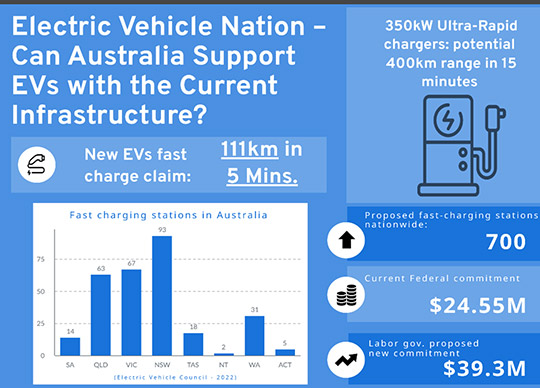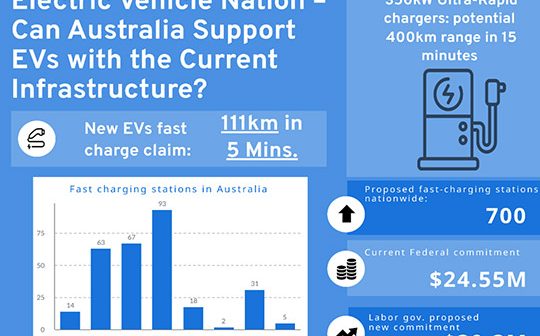
Historians have always noted Australia suffering from the “tyranny of distance” both internationally and internally. We are remote as a continental island – a country that’s nearly 7.7 million km2 in size – and our major cities much more distant than other developed countries.
For example, the driving distance between Melbourne and Sydney is 878km; the distance between the capitals of New York State (Albany) and adjacent New Jersey (Trenton) is approximately 330km.
The fully electric Nissan Leaf would be able to travel from Albany to Trenton comfortably with a full range of 385km. However, it would need to stop at least twice to go from Melbourne to Sydney.
With petrol stations abundant in Australia, EV drivers may feel they could be left in the lurch. But is it as dire as public perceptions seem?
In this report, we use the Electric Vehicle Council of Australia March 2022 data to answer questions such as, how many public charging stations are there in Australia? How many are planned for the future? Where are they now, and where will they be located? We investigate what’s available for EV owners and prospective owners.
THE TYPES OF EV CHARGING STATIONS
Electric vehicles – such as fully electric or Plug-in Hybrid Electric vehicles (HEV) – require electric power from the grid to run (although not fully for Hybrids, which run on a mix of electric and petrol.)
EVs require DC power – which is either supplied at a charging station direct or converted from AC to DC by the car’s internal converter. DC charging is the fastest way to charge an electric vehicle.
Typically, one kilowatt (kW) will add one kilometre for each ten minutes of charging.
AC public charging stations fall into the range of about 7kW to 40kW and are usually referred to as “destination charging” stations, allowing cars to be recharged overnight. The cars themselves may only get a fraction of that throughput after the conversion.
DC charging stations are much quicker in comparison and designed for immediate top-ups.
There are two types of DC public charging stations – above 50kW fast charging and below 50kw regular charging.
At 50kW, a vehicle will add 50km of range (on average) for each ten minutes of charge.
The fastest available charging stations in Australia are 350kW “ultra-rapid” facilities, such as those offered by providers like Chargefox, for example. Chargefox provides a theoretical 400km of range in 15 minutes, though, these are few and far between. More have been promised by state and federal governments in the coming years.
Even if every DC charging point was capable of 350kW output, the vehicles themselves are limited by what they can accept. Until recently, top of the line EVs in Australia with DC maximums of 110kW to 200kW were considered high, however the latest vehicles such as Hyundai’s Iconiq 5 and the Kia EV6 both have max per hour charge speeds of 350kW.*
Other factors affect total charge time however, such as batter size or capacity. Furthermore, EV battery charging does not proceed in a linear fashion. kW charging power will peak early and decline as the charge increases. As such, EV brands talk about time to charge from “10% – 80%”. Using the Iconiq 5 as an example, it claims to take only 18 minutes to charge from 10-80% for both its long range and standard battery.
THE NUMBER OF PUBLIC EV CHARGING STATIONS VS LOCATIONS IN AUSTRALIA
Note that the number of public charging locations does not reflect the number of individual charging points. There may be many points at one location.
FAST CHARGING
As of January 2022, there are 293 fast charging locations around Australia. This represents an increase of 85% since August 2020 (157).


Unsurprisingly, the distribution of these stations matches the population density of each respective state.
Bill Tsouvalas, Savvy Managing Director & Electric Vehicle loan expert said “Australians are increasingly eager to get make their next new car purchase an EV. We can see this reflected in the volume of car finance enquiries. There are a couple of sticking points that are stopping electric cars from going gangbusters though. The first and most obvious one is price: they’re still too expensive for mass uptake. I reckon the price will have to drop below 40 or $50k before we see wider mass adoption.”
“The other big issue is charging time. People have gotten used to not having to wait for anything. When we fill up our regular cars at the pump, it takes five minutes max, in and out. Who is going to be willing to spend an hour charging their car on a long journey? What if you get there and all the bays are full? I’m still not convinced this problem has been solved. We are seeing inroads now however, with the increase in 350kW ultra-rapid chargers and cars coming out that can take advantage of that. So, my prediction is that when prices drop below $50k and charging times drop below 15 minutes, you can expect a real EV boom.”
REGULAR CHARGING
As of January 2022, there are 1,580 regular charging stations in Australia. This represents an increase of 29% since August 2020 (1219.)


This also matches population density, though WA with 202 is an outlier.
FINDING CHARGING STATIONS
The EV community has pitched in to help fellow drivers by providing a free cross-platform app called PlugShare.
PlugShare allows users to find charging stations in Australia and worldwide, map new ones and share their EV activity with other enthusiasts.
Google has already rolled out an EV charging station finder in the United Kingdom and United States, with countries such as Australia and New Zealand to follow.
THE FUTURE OF CHARGING
State and federal governments are supporting the rollout of additional fast charging stations around Australia.
The Electric Vehicle Council, based on estimates of funding from state and federal governments, says that 700 new fast charging locations will be added across Australia over the next five years. Each location will have multiple charging points to accommodate many vehicles.
Other state government programs will increase the density of fast charging equipment currently in use, so more cars can take advantage of charging at the same time.
Federal
The previous Coalition government pledged $24.55 million to co-funding 400 fast-chargers across approximately 200 sites, mainly in metropolitan locations.
The new Labor government announced a pre-election policy of a $39.3 million investment in a national electric vehicle charging network to establish charging stations every 150km on Australia’s major transport route. The amount will be matched by the NRMA.
NSW
NSW will commit $131m to co-fund 1,000 fast charging bays across 250 locations.
ACT
Will co-fund 20 new fast chargers.
NT
Have committed funding to fast-charging, with details to come.
QLD
QLD’s “Queensland Electric Superhighway” will see 18 new fast-charging sites added at a cost of $2.75m.
SA
The SA government has pledged $13.4m to add 28 new regional fast charging stations.
TAS
Has committed $600,000 to build additional fast charging stations.
WA
$20 million pledged to fund fast charging stations across 45 sites in regional WA.
VIC
The government has promised $6m to co-funding fast charging stations across 50 regional Victorian locations.






